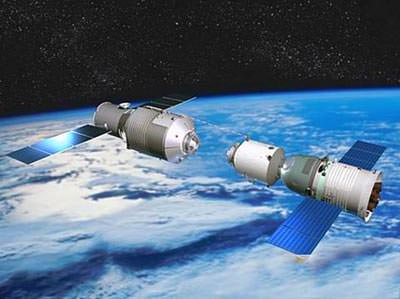China is planning to launch their own space station, named Tiangong, by the end of 2010 or beginning of 2011. There have been a few instances where information about the station surfaces briefly over the past few years about the development of the space station. Specific details on the program are not being release in large doses by the Chinese National Space Administration (CNSA), so the development of the station is somewhat shrouded in mystery.
Qi Faren, one of the designers of the Shenzhou-5 spacecraft, said in an interview on CCTV last month of the upcoming launch, “Quality is the key to technology. We must guarantee a successful launch. We will launch it whenever we are ready. It will be the end of 2010, or the beginning of 2011.”
Here’s what is known about the program: the Tiangong – which means “Heavenly Palace” – station will start out much as the ISS and Mir did, with a small module to house taikonauts. This component, named Tiangong-1, and shown above, is estimated to be an 8.5-ton module that will have life-support and solar energy production facilities. It’s a rather small module, with not much more room than the Shenzou spacecraft that will later carry taikonauts to the station.
The CNSA unveiled a model of the station during TV special celebrating the New Year in January 2009, but not much more has been said until the most recent statements regarding its potential launch dates.
Shenzhou-7 was the last manned Chinese spacecraft to launch, and it brought astronaut and former fighter pilot Zhai Zhigang into space for China’s first spacewalk. The next launch of a Shenzhou spacecraft, Shenzou-8, will be unmanned and is planned to dock with Tiangong-1, reminiscent of the ESA’s Automatic Transfer Vehicle. Of course, details about the date of this launch will be forthcoming pending the launch of the station itself. This docking mission could last a few weeks to a few months, and will carry a payload of scientific experiments.
After that, Shenzhou-9 and -10 will likely carry taikonauts up to the station. It isn’t really clear whether Shenzhou-9 will be another unmanned docking mission, or will carry the first of the taikonauts to board the station. The success of Shenzhou-8 will have a lot to do with whether the following launch will be manned or not. Any of the missions to the station containing humans would be shorter than the unmanned docking missions for the logistical problems raised by bringing humans into space.
According to the Chinese Academy of Sciences, scientific and support modules will eventually be added to the station, named Tiangong II and Tiangong III.
Further down the road, China plans to build a larger, more long-term space facility. Zhang Jianqi, Deputy Commander-in-Chief of China’s Manned Space Engineering Program, told the Xinhua News Agency last March, “…We will go all out to build a long-term manned space station by 2020.” This fits in well with China’s plans to take humans to the Moon after 2020, as it could provide a support platform for such a venture.
As the launch of the newest addition to human outposts in space approaches, we’ll hopefully get more information as to the details of Tiangong.
Source: Spacedaily, Chinese Academy of Sciences


THE WORLD IN 2050.
Nice new layout, and my comments work again!
All I can think of is in Clarke’s 2061 China launches a space station that becomes a spaceship.